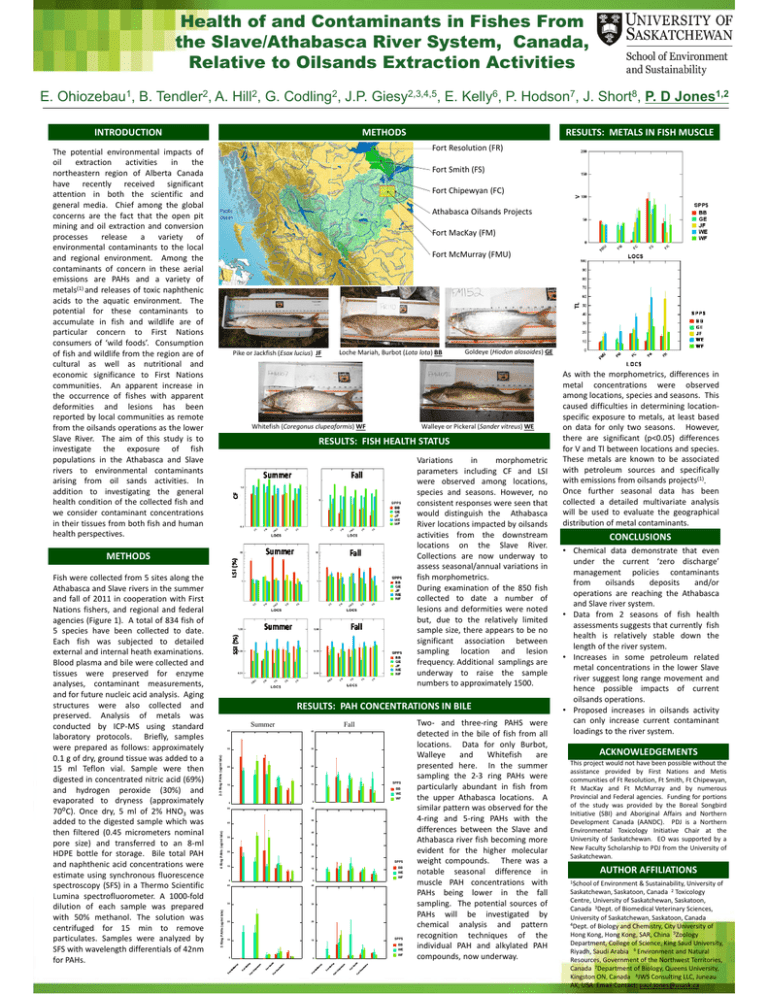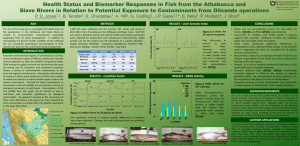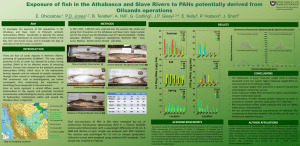INTRODUCTION
advertisement

Health of and Contaminants in Fishes From the Slave/Athabasca River System, Canada, Relative to Oilsands Extraction Activities E. Ohiozebau1, B. Tendler2, A. Hill2, G. Codling2, J.P. Giesy2,3,4,5, E. Kelly6, P. Hodson7, J. Short8, P. D Jones1,2 INTRODUCTION METHODS Fort Smith (FS) Fort Chipewyan (FC) Athabasca Oilsands Projects Fort MacKay (FM) Fort McMurray (FMU) Pike or Jackfish (Esox lucius) JF Loche Mariah, Burbot (Lota lota) BB Goldeye (Hiodon alosoides) GE Walleye or Pickeral (Sander vitreus) WE Whitefish (Coregonus clupeaformis) WF RESULTS: FISH HEALTH STATUS Variations in morphometric parameters including CF and LSI were observed among locations, species and seasons. However, no consistent responses were seen that would distinguish the Athabasca River locations impacted by oilsands activities from the downstream locations on the Slave River. Collections are now underway to assess seasonal/annual variations in fish morphometrics. During examination of the 850 fish collected to date a number of lesions and deformities were noted but, due to the relatively limited sample size, there appears to be no significant association between sampling location and lesion frequency. Additional samplings are underway to raise the sample numbers to approximately 1500. METHODS RESULTS: PAH CONCENTRATIONS IN BILE 2-3 Ring PAHs (ug/ml bile) Summer Fall 40 40 30 30 20 20 10 10 SPP$ BB WE WF 0 50 0 60 50 4 Ring PAHs (ug/ml bile) 40 40 30 30 20 20 SPP$ 10 10 BB WE WF 5 Ring PAHs (ug/ml bile) Fish were collected from 5 sites along the Athabasca and Slave rivers in the summer and fall of 2011 in cooperation with First Nations fishers, and regional and federal agencies (Figure 1). A total of 834 fish of 5 species have been collected to date. Each fish was subjected to detailed external and internal heath examinations. Blood plasma and bile were collected and tissues were preserved for enzyme analyses, contaminant measurements, and for future nucleic acid analysis. Aging structures were also collected and preserved. Analysis of metals was conducted by ICP‐MS using standard laboratory protocols. Briefly, samples were prepared as follows: approximately 0.1 g of dry, ground tissue was added to a 15 ml Teflon vial. Sample were then digested in concentrated nitric acid (69%) and hydrogen peroxide (30%) and evaporated to dryness (approximately 70ᴼC). Once dry, 5 ml of 2% HNO3 was added to the digested sample which was then filtered (0.45 micrometers nominal pore size) and transferred to an 8‐ml HDPE bottle for storage. Bile total PAH and naphthenic acid concentrations were estimate using synchronous fluorescence spectroscopy (SFS) in a Thermo Scientific Lumina spectrofluorometer. A 1000‐fold dilution of each sample was prepared with 50% methanol. The solution was centrifuged for 15 min to remove particulates. Samples were analyzed by SFS with wavelength differentials of 42nm for PAHs. RESULTS: METALS IN FISH MUSCLE Fort Resolution (FR) The potential environmental impacts of oil extraction activities in the northeastern region of Alberta Canada have recently received significant attention in both the scientific and general media. Chief among the global concerns are the fact that the open pit mining and oil extraction and conversion processes release a variety of environmental contaminants to the local and regional environment. Among the contaminants of concern in these aerial emissions are PAHs and a variety of metals(1) and releases of toxic naphthenic acids to the aquatic environment. The potential for these contaminants to accumulate in fish and wildlife are of particular concern to First Nations consumers of ‘wild foods’. Consumption of fish and wildlife from the region are of cultural as well as nutritional and economic significance to First Nations communities. An apparent increase in the occurrence of fishes with apparent deformities and lesions has been reported by local communities as remote from the oilsands operations as the lower Slave River. The aim of this study is to investigate the exposure of fish populations in the Athabasca and Slave rivers to environmental contaminants arising from oil sands activities. In addition to investigating the general health condition of the collected fish and we consider contaminant concentrations in their tissues from both fish and human health perspectives. 0 0 40 40 30 30 20 20 10 10 0 0 SPP$ BB WE WF Two‐ and three‐ring PAHS were detected in the bile of fish from all locations. Data for only Burbot, Walleye and Whitefish are presented here. In the summer sampling the 2‐3 ring PAHs were particularly abundant in fish from the upper Athabasca locations. A similar pattern was observed for the 4‐ring and 5‐ring PAHs with the differences between the Slave and Athabasca river fish becoming more evident for the higher molecular weight compounds. There was a notable seasonal difference in muscle PAH concentrations with PAHs being lower in the fall sampling. The potential sources of PAHs will be investigated by chemical analysis and pattern recognition techniques of the individual PAH and alkylated PAH compounds, now underway. As with the morphometrics, differences in metal concentrations were observed among locations, species and seasons. This caused difficulties in determining location‐ specific exposure to metals, at least based on data for only two seasons. However, there are significant (p<0.05) differences for V and Tl between locations and species. These metals are known to be associated with petroleum sources and specifically with emissions from oilsands projects(1). Once further seasonal data has been collected a detailed multivariate analysis will be used to evaluate the geographical distribution of metal contaminants. CONCLUSIONS • Chemical data demonstrate that even under the current ‘zero discharge’ management policies contaminants from oilsands deposits and/or operations are reaching the Athabasca and Slave river system. • Data from 2 seasons of fish health assessments suggests that currently fish health is relatively stable down the length of the river system. • Increases in some petroleum related metal concentrations in the lower Slave river suggest long range movement and hence possible impacts of current oilsands operations. • Proposed increases in oilsands activity can only increase current contaminant loadings to the river system. ACKNOWLEDGEMENTS This project would not have been possible without the assistance provided by First Nations and Metis communities of Ft Resolution, Ft Smith, Ft Chipewyan, Ft MacKay and Ft McMurray and by numerous Provincial and Federal agencies. Funding for portions of the study was provided by the Boreal Songbird Initiative (SBI) and Aboriginal Affairs and Northern Development Canada (AANDC). PDJ is a Northern Environmental Toxicology Initiative Chair at the University of Saskatchewan. EO was supported by a New Faculty Scholarship to PDJ from the University of Saskatchewan. AUTHOR AFFILIATIONS 1School of Environment & Sustainability, University of Saskatchewan, Saskatoon, Canada 2 Toxicology Centre, University of Saskatchewan, Saskatoon, Canada 3Dept. of Biomedical Veterinary Sciences, University of Saskatchewan, Saskatoon, Canada 4Dept. of Biology and Chemistry, City University of Hong Kong, Hong Kong, SAR, China 5Zoology Department, College of Science, King Saud University, Riyadh, Saudi Arabia 6 Environment and Natural Resources, Government of the Northwest Territories, Canada 7Department of Biology, Queens University, Kingston ON, Canada 8JWS Consulting LLC, Juneau AK, USA Email Contact: paul.jones@usask.ca





